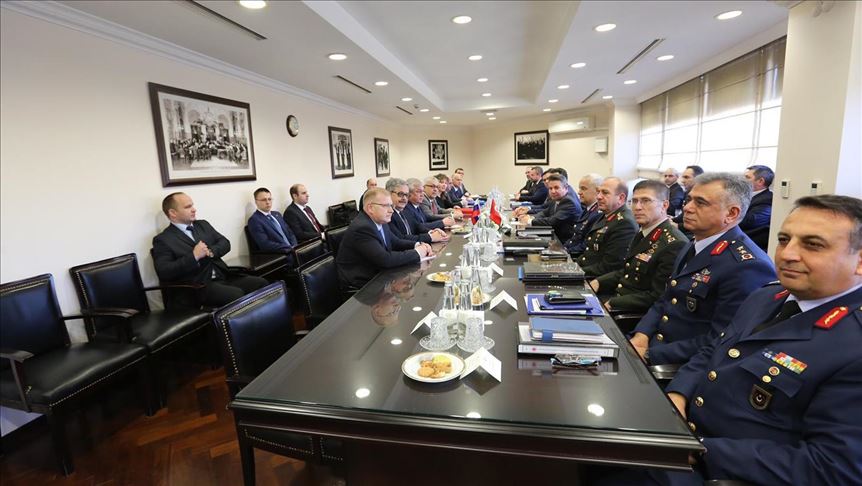The U.S.-led coalition ostensibly fighting ISIS in both Syria and Iraq confirmed that the incident had occurred at a checkpoint near the town of Qamishli, which is situated right on the Syrian-Turkish border in Syria's northeastern corner.
Syrian state media said that
the altercation had taken place specifically on a stretch of road in the village of Khirbet Ammu, to the east of Qamishli. The U.S. forces were traveling in a convoy in a mix of M-ATV and MRAP mine-resistant wheeled armored vehicles at the time.
After Coalition troops issued a series of warnings and de-escalation attempts,
the patrol came under small arms fire from unknown individuals. In self-defense, Coalition troops returned fire, U.S. Army Colonel Miles Caggins III, the top spokesperson for the U.S.-led coalition, also known as Combined Joint Task Force-Operation Inherent Resolve, said in a statement. "The situation was de-escalated and is under investigation. The Coalition patrol returned to base."
Caggins later issued a second statement saying that "one U.S. Soldier had a minor superficial scratch while operating their equipment" during the incident and that "the Soldier is back at work."
Pictures show that U.S. Air Force F-15s, possibly F-15E Strike Eagles, which have
been very active in the region, conducted a show of force during the incident, flying over the area and firing off flares. Syrian authorities
claimed there had been an actual airstrike, but there is no evidence of this. Combat jets and helicopters firing flares overhead is a common show of force tactic, which U.S. forces have employed
in both Syria and
Iraq in the past.
Syrian state media also claims that U.S. forces opened fire on civilians and that they killed one of them. The videos and pictures that have since emerged on social media do show what appear to be civilians milling around the checkpoint, as well as in heated discussions with American troops. In one case, an individual is seen holding a torn U.S. flag,
reportedly pulled off of one of the American vehicles.
However, there is no evidence that American forces deliberately fired at civilians. At least one video clip
shows members of the pro-Assad force manning the checkpoint firing at the U.S. convoy while not wearing readily discernable military uniforms.
There are indications that some of the U.S. M-ATVs and MRAPs had suffered some damage in the incident. Pictures reportedly from the aftermath of the incident show one M-ATV being towed away and superficial damage to another vehicle. Some videos show apparent civilians or militia members pelting the vehicles with rocks and possibly throwing at least one Molotov cocktail at them.
Though it is not entirely clear when they arrived, Russian forces, who are ostensibly aligned with Assad's regime and patrol areas of northeastern Syria under a separate agreement with the Turkish government, were also present during the incident. The U.K.-based Syrian Observatory for Human Rights, an independent monitoring group, said its sources indicated that
the Russians attempted to de-escalate the situation, according to the Associated Press. Video available on social media clearly shows that Russia's troops had arrived before the shooting started and were there during the skirmish. At the time of writing, there were no reports of Russian casualties.
This incident follows weeks
of increasingly routine standoffs between U.S. and Russian forces in northeastern Syria, typically with the Americans seeking to block the passage of Russia's patrols into certain areas under the control of the U.S.-backed predominantly Kurdish Syrian Democratic (SDF) forces. A
fistfight reportedly broke out between American and Russian troops in January, but this specific incident remains unconfirmed.
Russia has been conducting these activities in northeastern Syria since October 2019, when officials and Moscow and Ankara
cut a deal creating a buffer zone along the Syrian-Turkish border. This followed a
unilateral Turkish military intervention into northern Syria, primarily aimed at ejecting the SDF from the region.
There was also a report on Feb. 9, 2020, that U.S. forces had begun building a new, semi-permanent outpost in the city of Hasakah, a major hub and capital of the province of the same name, roughly 45 miles southwest of Qamishli. That comes
amid major questions about the U.S. military's force posture in Syria, as a whole, and the future of the American military's presence there.
The skirmish near Qamishli also comes as Turkish forces and their local partners increasingly find themselves in open conflict with pro-Assad forces in western Syria. The regime in Damascus has launched a new offensive to retake the province of Idlib, the last remaining major rebel stronghold, which has also precipitated
a new humanitarian disaster. Turkey
has complained about Russia's unwillingness or inability to prevent this Syrian military operation, which authorities in Ankara say violates its deal with Moscow. At least 13 Turkish troops have died in Syrian artillery strikes in February alone, according to
the Associated Press.
“The United States once again condemns the continued, unjustifiable, and ruthless assaults on the people of Idlib," U.S. Secretary of State Mike Pompeo
said in a statement on Feb. 4, following an attack by pro-Assad forces on a Turkish outpost in Syria. "We stand by our NATO ally Turkey in the aftermath of the attack, which resulted in the death of multiple Turkish personnel serving at an observation post used for coordination and de-escalation, and fully support Turkey’s justified self-defense actions in response."
However, on Feb. 11, National Security Advisor Robert O'Brien indicated that the U.S. government would not seek to intervene in the brewing conflict. “What are we supposed to do to stop them? We’re supposed to be a global policeman and hold up a sign and say stop this Turkey, stop this Russia?” he said on CBS's
Face the Nation.
All told, the situation on the ground in Syria looks as complex and multi-faceted as ever. The skirmish near Qamishli and the number of different actors involved only underscore the inherent risks of these ostensibly minor altercations in the country spiraling out of control and turning into larger and more serious conflicts.
UPDATE: 3:45pm EST
Russia has claimed that a 14-year-old boy died in the incident and that another was wounded.
"One local resident was wounded. Another resident – a 14-year-old boy – was killed," Russian Major General Yury Borenkov, the head of the Russian government's Center for Syrian Reconciliation, said
in a daily briefing. "Only thanks to the efforts of the Russian servicemen, who arrived at the site of the incident, it was possible to prevent a further escalation of the conflict with the locals and to ensure the exit of the U.S. military convoy in the direction of a U.S. base in near the village of Khimo in Haseke province."
Local Syrian media has named the individual who reportedly died as Faisal Khalid Al Bari, but does not appear to have given his age.
U.S. Secretary of Defense Mark Esper has also challenged the Russian assertion that its forces were instrumental in defusing the situation. "Today’s incident did not involve the Russians," he told reporters at NATO headquarters in Brussels, Belgium, where he is attending a meeting of senior defense officials from around the Alliance.













